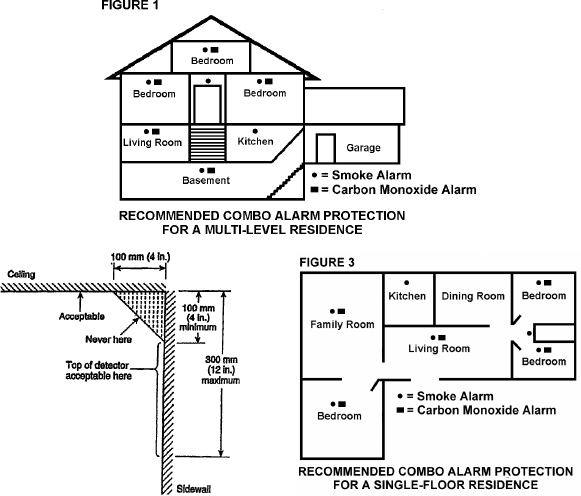
Page 4
INSTALLING THE COMBINATION SMOKE/CO ALARM
FOR RESIDENTIAL USE
LOCATION
Before installing your combination smoke/CO alarm, it is important to choose the best
locations in your home. Placement can affect how well the alarm performs and how well
residents hear the alarm if it sounds. Statistics of the National Fire Protection Association
(NFPA) show that most of the fatal CO occurrences happen at night while people are
sleeping.
Early warning of CO is best achieved by the installation of CO alarms on all floors and
areas of the household.
RECOMMENDATIONS
– Put a CO alarm inside each bedroom where the occupant closes the door while sleeping.
Particulate smoke can be blocked by a closed door, but CO fumes are likely to get
through.
– A CO alarm should be installed between 5 and 20 feet from potential sources of CO in
any family living unit containing a fuel-burning appliance or fireplace or having an attached
garage.
– A combination smoke/CO alarm should be centrally located outside of each separate
sleeping area in the immediate vicinity of the bedrooms. Where bedrooms are separated
and audibility of the alarm to occupants within the bedroom area could be seriously
impaired, more than one unit could be needed.
– If a bedroom area hallway is more than 30 feet long, install a smoke alarm at each end.
– Alarms can alert you to a problem only after smoke or CO reach their sensors. Choose
locations free of obstructions, where the alarm will stay clean and protected from adverse
environmental conditions.
– Install a smoke or combination alarm on the basement ceiling at the bottom of the stairwell.
– Make sure the alarms can be easily heard from multiple locations throughout the home.
– This combination smoke/CO alarm makes it easy to provide both types of protection
throughout the home.
– This combination smoke/CO alarm is designed to be used in single-family homes. It
alone may not meet requirements for multiple-resident dwellings (apartment buildings,
boarding houses, hotels or motels).
FIGURE 2











